WHO was Montessori?
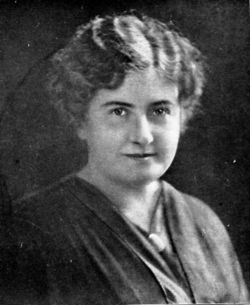
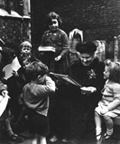
The Montessori Method is named after a real person. Doctor Maria Montessori, who was ahead of her time and a true pioneer. To read about this exceptional woman, and of the events leading up to her conceiving such progressive theories and practices, is quite fascinating.Maria Montessori was born in Italy in 1870 in the town of Chiaravalle, in the province of Ancona, Italy. Coming from a family of a supportive mother and a conservative father her parents often differed on how to raise her. Her father usually pushing for a more traditional female role, while her mother encouraging her to follow her desires. She was close with her father until his death, but it was clearly her mother who supported her. Without her mother’s well wishes she would have not made the first move in her educational career to enter technical school at the age of thirteen.
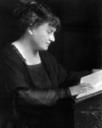

Maria began studies in engineering at the Regia Scuola Tecnica Michelangelo Buovarrotientered school specifically with math as a major component. At this time this field and all others related to it were reserved for men and her presence was not welcomed by either the other students or staff. From this experience she began to model what a school should not be like. She also made the decision not to continue studies in engineering. Her relatives, friends, and father were all relieved to hear that she would veer away from such an un-ladylike discipline, but were quite dismayed when they found out the change was from engineering to medicine. Yet dispite all the disapproval, in 1896 she became the first woman in Italy to receive a medical degree.

After receiving her medical degree Maria had many varied experiences and positions. (She later related this to her philosophy of education in that the child should be offered opportunities that lead to new skills and other experiences.) She was chosen to represent Italy at two different women’s conferences, one in Berlin in 1896 and one in London in 1900.She was also on the staff of the Orthrophrenic Psychiatric Hospital for “mentally deficient” children. She studied Itard and Seguin, who had researched how people learn. She studied anthropology, psychology and philosophy. Soon her clinical observations led her to analyze how children learn, and she concluded that they build themselves from what they find in their environment. Shifting her focus from the body to the mind, she returned to the university in 1901, this time to study psychology and philosophy. In 1904, she was made a professor of anthropology at the University of Rome.In 1906 she gave up both her university chair and her medical practice and began to work with a group of sixty young children of working class parents in the San Lorenzo district of Rome. Although they were “normal” children, they entered her program “wild and unruly” , and were considered developmentally “deprived” by the powers that be. Maria believed their behavior was due to an impoverished environment. (Having two working parents, she believed that they possessed a lack of understanding from being left alone all day.) Maria placed them in a small room, hired and untrained teacher whom she taught to observe the children and respond to their questions and needs, and observed the results. Much everyone’s surprise, they began to respond to her teaching methods and the first Casa dei Bambini, or “Children’s House” was founded.

(the Casa dei Bambini on opening day)By careful observations both in and out of the Casa dei Bambini, Montessori realized that children related to, and reacted with their environment. So in her classrooms, she began to put out materials and continued to observe the children. Many of these materials developed daily living skills that the children lacked. She also enhanced the child’s senses with other materials. Based upon her observations, she noticed that these children almost effortlessly absorbed knowledge from their surroundings. She also noticed a tireless interest in manipulating materials. These two critical observations are what ultimately became the cornerstone of the Montessori method. Maria Montessori made her first visit to the United States in 1913, the same year that Alexander Graham Bell and his wife Mabel founded the Montessori Educational Association at their Washington, DC, home. Among her other strong American supporters were Thomas Edison and Helen Keller.In 1915, she attracted world’s attention with her “glass house” schoolroom exhibit at the Panama-Pacific International Exhibition in San Francisco. On this second U.S. visit, she also conducted a teacher training course and addressed the annual conventions of both the National Education Association and the International Kindergarten Union. The committee that brought her to San Francisco included Margaret Wilson, the daughter of U.S. President Woodrow Wilson.
The Spanish government invited her to open a research institute in 1917. In 1919, she began a series of teacher training courses in London. In 1922, she was appointed a government inspector of schools in her native Italy. In 1929, Maria established the Association Montessori Internationale (AMI) to support her training programs and the development of new materials for the classrooms. This was a time of upheaval, but also a period of deep development for Montessori. She was asked by Mussolini to train the children of Italy in his doctrine. She refused, and so in 1934, because of her opposition to Mussolini’s fascism, she was forced to leave Italy. She traveled to Barcelona, Spain, and was rescued there by a British cruiser in 1936, during the Spanish Civil War. She opened the Montessori Training Centre in Laren, Netherlands, in 1938, and founded a series of teacher training courses in India in 1939.
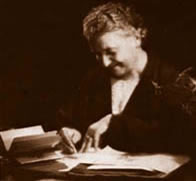
In 1940, when India entered World War II, she and her son, Mario Montessori, were interned as enemy aliens, but she was still permitted to conduct training courses. It is during this time that her Education for Peace was developed. She viewed the child as the hope of mankind, the builder of culture, and took great care to articulate this philosophy to others. Because of her passion and dedication to Peace Education, she was nominated for the Nobel Peace Prize three times–in 1949, 1950, and 1951.
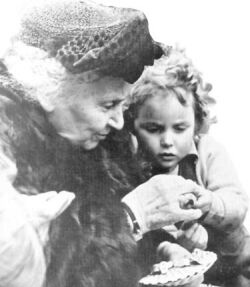
Maria Montessori died in Noordwijk, Holland, in 1952, a citizen not of Italy, nor of Holland, but as she was so often quoted saying, “of the world”. Upon her death her son Mario took over her work. In 1960 the American Montessori Society (AMS) was established in the United States.Since 1952 Montessori philosophy continues to grow and thrive throughout the world. There are many organizations that support, in one way or another, some interpretation of the Montessori philosophy.
For more information on Maria Montessori and her life’s work, please refer to these books:
Rita Kramer, Maria Montessori: A Biography”, 1976
E.M. Standing, “Maria Montessori: Her Life and Work”, 1957
Barbara O’Connor, “Mammolina: A Story About Maria Montessori (Creative Minds Biography)
BIBLIOGRAPHY:
“History of the Montessori Method of Education”, Pat Davis (c) ESH Project Leaders Consortium
“Maria Montessori: A Brief Biography”, O”kemos Montessori Radmoor History ”
http://www.okemosmontessori.org/history.htm
http://www.islandmontessori.com/history.htm